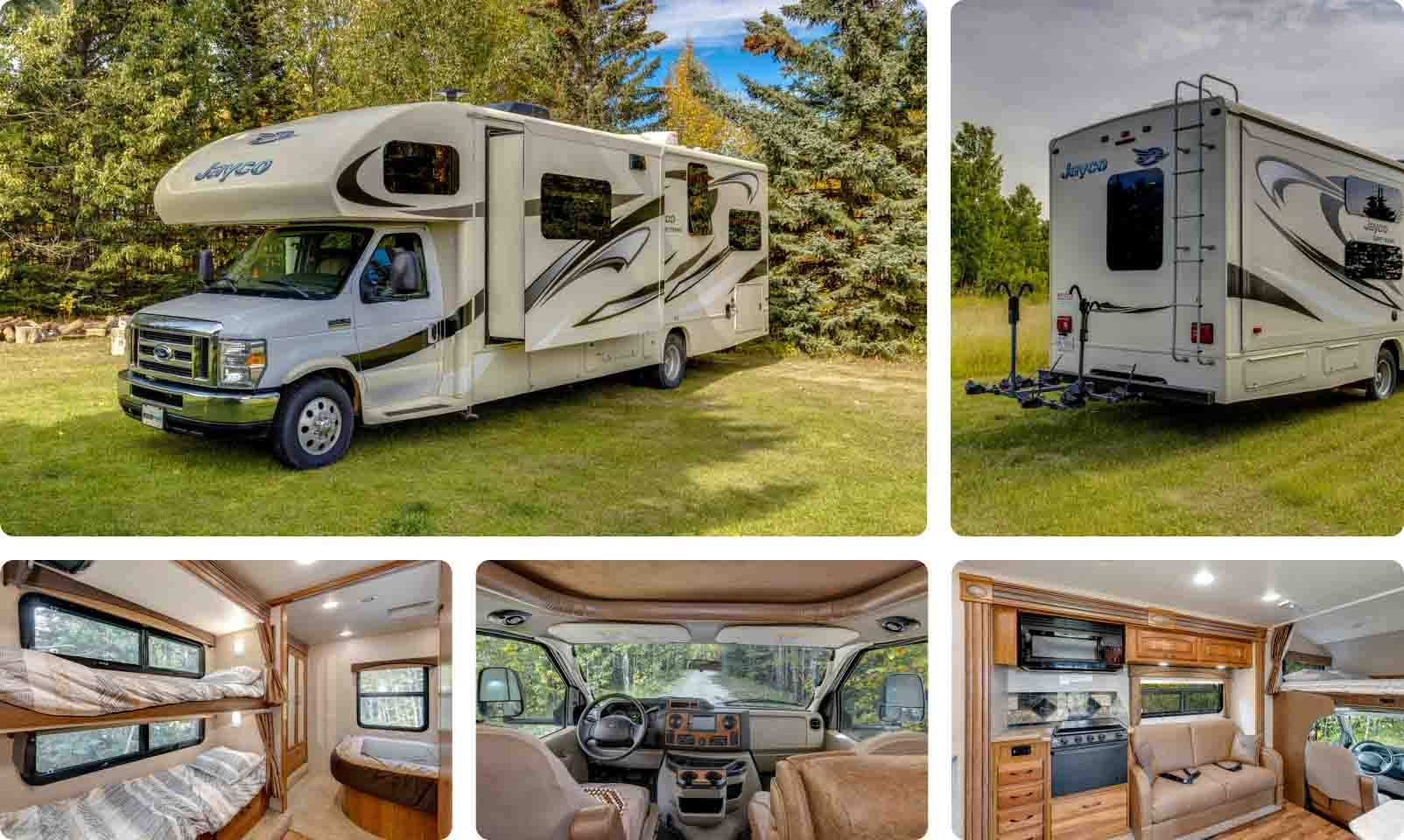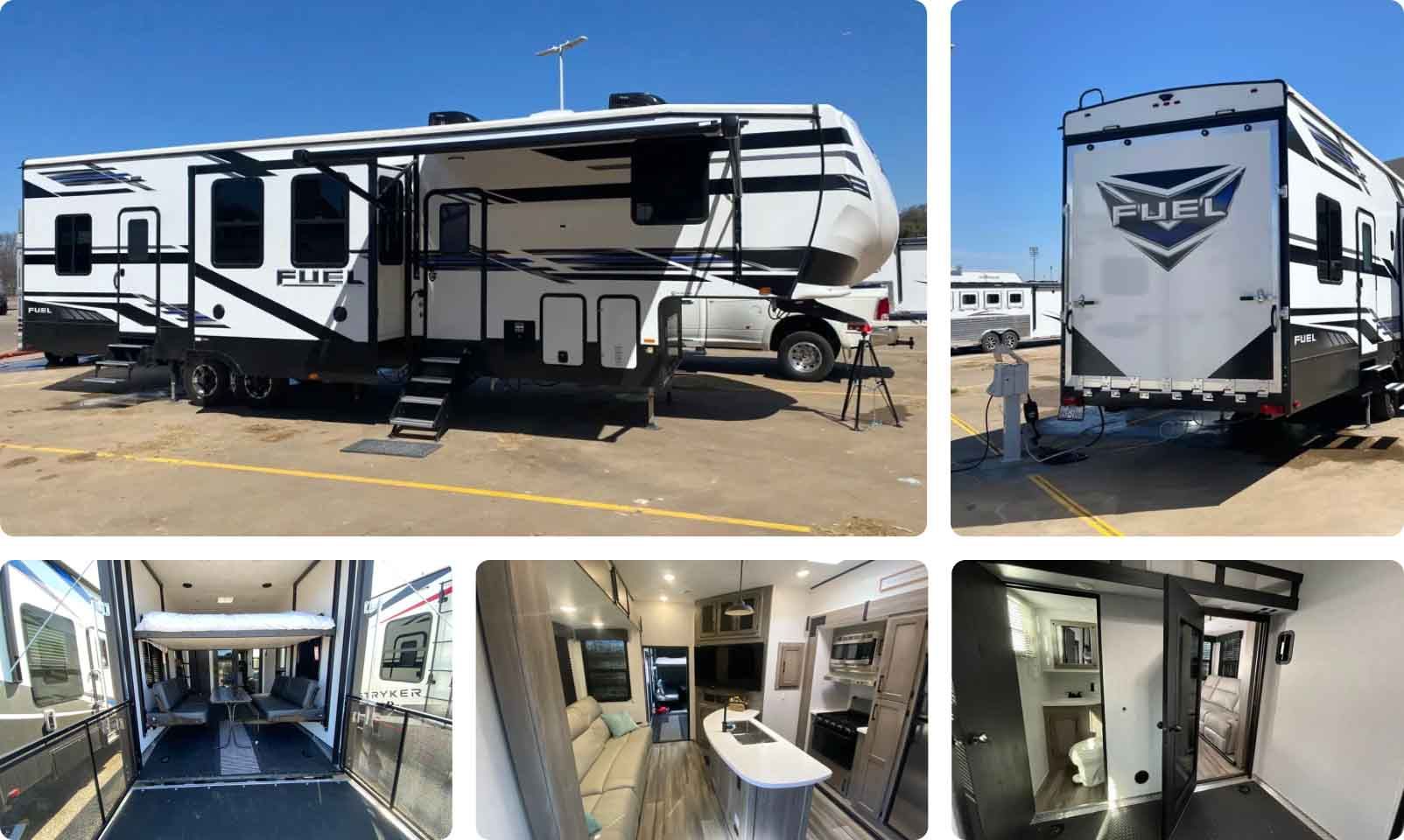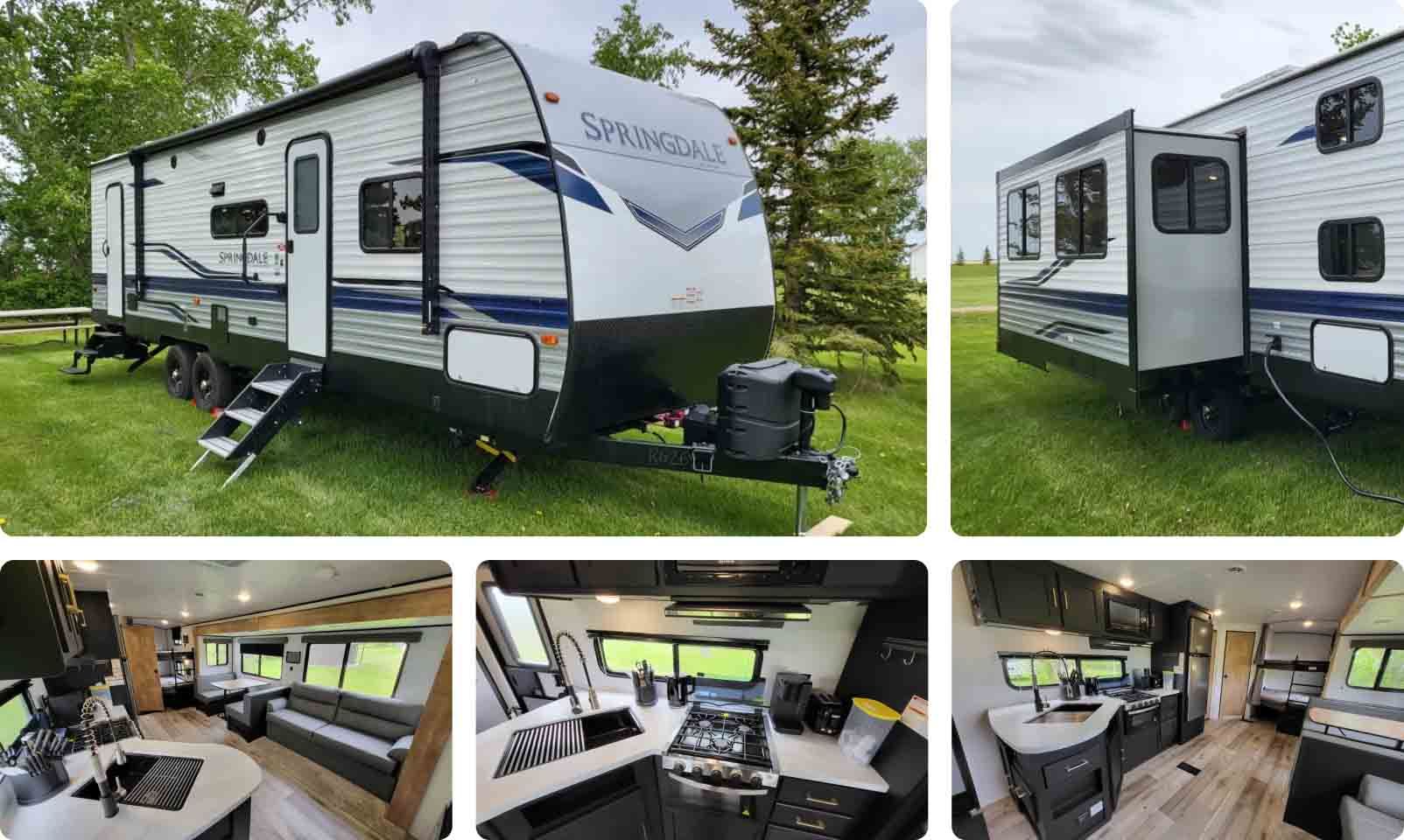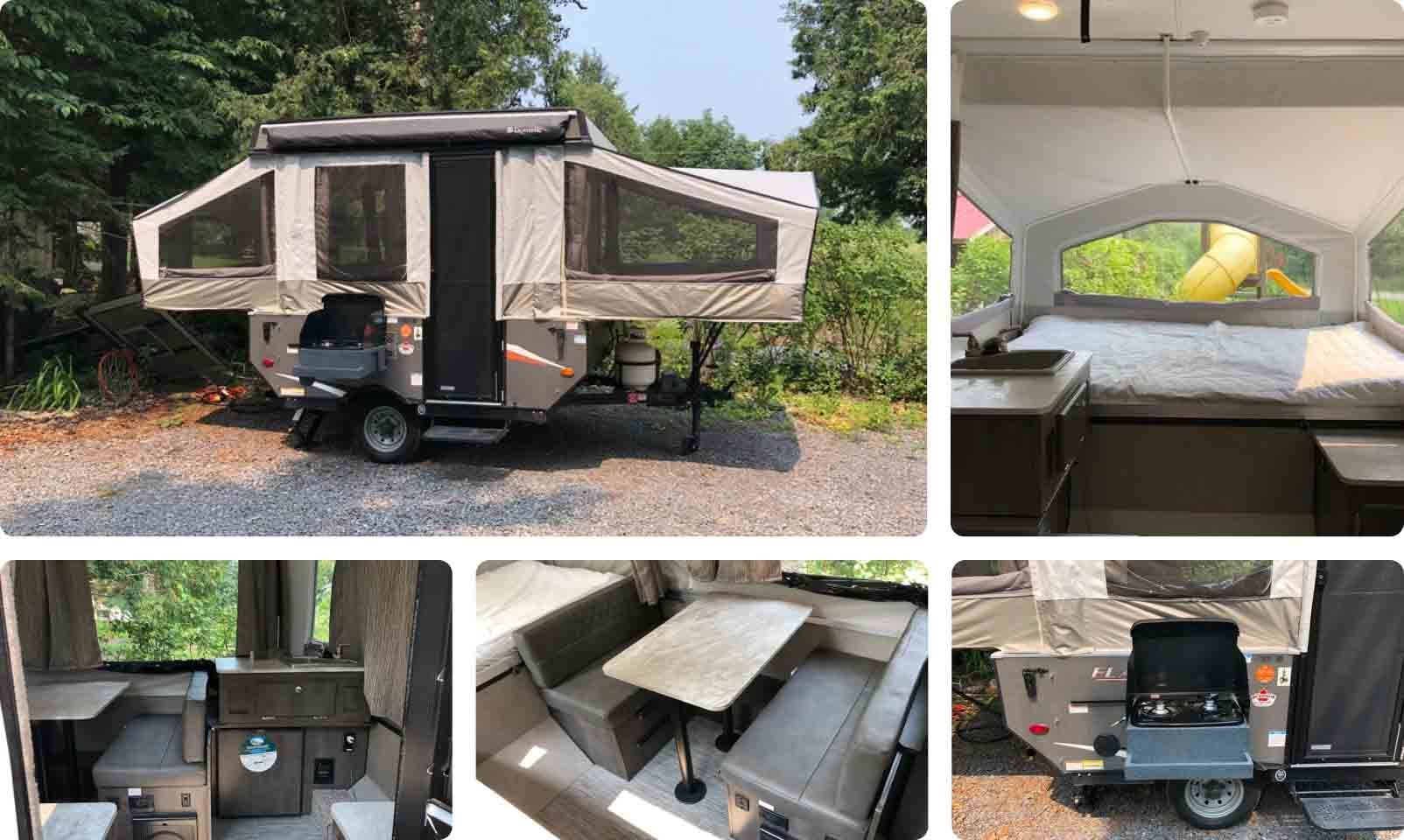Best RVsRV ownershipRV beginner
The 9 Different RV Types Explained [Visual Guide]
Posted on July 7, 2021
![The 9 Different RV Types Explained [Visual Guide]](https://ghost-cdn.rvezy.com/2021/07/rv-types.jpg)
In this article, we’re going to give you information about the nine different types of RVs.
The best way to know which RV has the amenities you want and need is to weigh the pros and cons of each RV type.
While it’s easy to choose an RV based on its physical features, the RV that will best suit your needs might not be the RV you're drawn to aesthetically.
Let’s compare RVs!
- Class A motorhomes
- Class B motorhomes
- Class C motorhome
- Fifth wheel
- Toy haulers
- Travel trailers
- Pop-up campers
- Tiny travel trailers
- Truck campers
Class A motorhomes
Characteristics
Class A motorhomes are the biggest drivable RVs and are often associated with luxury and comfort. Their large bus frames are built on a truck chassis providing RV manufacturers with the flexibility to make heavier and more spacious RVs. Class A motorhomes come with two types of engines. The smaller, more lightweight models typically have a gas engine, while the larger and heavier models come with a diesel engine. Regardless of the engine, most Class As have amenities like residential appliances, upgraded flooring and furniture, and ample underbelly storage. Because Class A RVs can handle more weight, the freshwater, black, and gray tanks are almost always bigger than those installed on smaller RVs.
Sleeps
Up to ten people.
RVezy pro tip: RV manufacturers design sleeping spaces differently. Before you rent or buy an RV, it’s a good idea to consult the host, view a floor plan, or check out the rig at a local dealership. Sometimes, RV beds have shorter mattresses or less space than a standard-sized bed.
Pros
- Residential home comforts.
- Large indoor living area.
- Easy set up at the campground.
- Plenty of storage space.
Cons
- Must park in oversized parking lots.
- Poor gas mileage.
- Some RVers may need a second tow-behind vehicle.
- Difficult to drive.

Class B motorhomes
Characteristics
Class B motorhomes, made popular by the van life movement, are the smallest drivable RVs on the market. Class Bs — also called campervans — come with two types of engines: gas and diesel. Class B RVs are nimble enough to fit in standard parking spaces yet big enough to have small kitchens, a flexible living and sleeping area, and sometimes even toilets and showers.
Class B RVs are different from conversion vans, cargo vans customized into living spaces by a third party.
Sleeps
Two to four people.
Pros
- Easy to drive.
- Fits in a standard parking space.
- National park and small campground friendly.
- Great for boondocking.
Cons
- Limited storage space.
- The motorhome is your primary vehicle.
- Small black, gray, and freshwater tanks.
- Convertible bed and living space.

Class C motorhome
Characteristics
Class C motorhomes are the most-rented type of RV on the road. Class Cs are built on a van chassis with the living space constructed around the cab. Class C RVs are versatile and easy to drive. The gas-powered engines are strong enough to withstand a heavy load yet still perform well on inclines and hills. Most Class C RVs have a bedroom, bathroom with a shower, a kitchen, and a convertible dinette-sleeping area. Usually, the signature cab-over bed serves as a secondary sleeping space, even though some people use that location for extra storage. While the Class C might look compact from the outside, these small motorhomes transform into comfortable living spaces when parked at the campground — especially the Class Cs that come with one or more slide outs.
Sleeps
Up to seven people.
Pros
- Easy to drive and park.
- Flexible living and sleeping space.
- Residential home comforts.
Cons
- Some RVers may want a second tow-behind vehicle.
- Average-size holding tanks.
- Poor gas mileage.
- Most owners will need off-site RV storage.

Fifth wheel
Characteristics
Fifth wheel travel trailers are the biggest towable RVs and one of the most popular types of RVs for full-time living. A fifth-wheel hitch is different from a bumper-pull because a fifth wheel connects a pin-box from the front of the trailer to a u-shaped coupling mounted in a truck bed. The truck bed connection helps to make fifth wheels ride smoother and more stable than a travel trailer, even though fifth wheels are almost always longer and heavier. Fifth wheels often have two levels with the upstairs level (the section that protrudes over the truck bed) housing the main bedroom or a bunk house-multipurpose area. Amenities like multiple slide outs, an outdoor kitchen, extendable patio, reclining chairs, office space, and a kitchen island help make fifth wheels some of the most comfortable and luxurious trailers on the road.
Sleeps
Up to eight people.
Pros
- Tons of storage space.
- Separate living and sleeping space.
- Unique features like bunk houses and sleeping nooks.
- Long-term and full-time friendly.
Cons
- Hard to park.
- Most owners will need off-site RV storage.
- Must tow with a heavy-duty or capable pickup truck.
- Too big for some national park campgrounds.

Toy haulers
Characteristics
Almost all toy haulers are either travel trailers or fifth wheels, but toy haulers are an RV type all their own because of their garages. Toy haulers have living areas and a multi-purpose utility space designed to carry motorcycles, off-road utility vehicles, kayaks, dirt bikes, or other toys inside of the RV. Some toy haulers have a designated garage space to keep the toys separate from the living quarters, while smaller toy haulers may have to share their living area with the toy during transit.
Sleeps
Up to seven people.
Pros
- Plenty of storage space.
- You don’t need a separate vehicle to bring your toys along.
- Made for off-grid camping.
Cons
- Shared living and toy space.
- Heavy.
- Made with rugged or easy-to-wash materials.
- Most owners will need off-site RV storage.

Travel trailers
Characteristics
Travel trailers are the most popular RVs on the market because they are versatile and come in many different lengths and weights. Travel trailers have hard sides and typically have a kitchen, a sleeping area, a bathroom, and a convertible dinette or living room that functions as a secondary sleeping space. Larger travel trailers may have slide outs and separate living and sleeping quarters and amenities like a bunkhouse or outdoor kitchen. The average size of a travel trailer ranges between 20 to 30 feet long and can stretch to 40 feet in length. Smaller travel trailers are also popular, giving tiny trailers a category of their own. To tow a travel trailer, you must have a tow vehicle with a sufficient tow rating and a hitch installed to connect the trailer.
Sleeps
Up to ten people.
Pros
- Huge variety to choose from.
- Budget friendly.
- Tow vehicle serves as additional storage.
- Park and play.
Cons
- Lower weight carrying capacity.
- Tow vehicle’s towing capacity.
- Limited storage space.
- Too large for a residential garage.

Pop-up campers
Characteristics
Pop-up campers look and function like hybrid RV tents. Depending on the model, the trailer frame typically has a hard-sided bottom section that houses the kitchen, dinette, storage, toilet, or shower (when available). When the camper is in driving mode, the tent section of the trailer collapses into the hard-sided bottom. When the pop-up camper is in camping mode, the tent section of the trailer extends to provide more headroom, sleeping space, and zippable sides and windows. People often choose pop-up campers because the streamlined profile is lightweight and easy to tow, and they cost less than most travel trailers.
Sleeps
Up to seven people.
Pros
- Budget friendly.
- Lower profile and lightweight.
- Stores in a residential garage.
- Perfect for tent campers who want to transition to an RV but aren’t ready to yet.
Cons
- Subject to noise and extreme temperatures — much like a tent.
- Some RV parks prohibit pop-up campers.
- Limited storage space.
- Low resale value.
Looking for more information about renting a pop-up camper? Here's everything you need to know.

Tiny travel trailers
Characteristics
Tiny travel trailers — sometimes called micro trailers — share similar features to traditional travel trailers, but they deserve their own category because of their small and flexible living spaces. Tiny travel trailers include teardrop, fiberglass, clamshell, and some smaller pop-ups. Some tiny travel trailers come self-contained with indoor kitchens and wet baths, while others have outdoor kitchens and a flexible living-sleeping area. Tiny travel trailers are popular because they are lightweight and smaller SUVs and trucks can tow them.
Sleeps
Two adults. Some tiny trailers may sleep up to four people.
Pros
- Lightweight.
- Easy to drive and park.
- National park friendly.
- Fits inside a residential-sized garage.
Cons
- Small inside.
- Stores in a residential garage.
- Small freshwater, gray, and black tanks.
- Not always self-contained.

Truck campers
Characteristics
Truck campers sit in the bed of a pickup truck, and because of weight, they almost always require a one-ton or a dually (dual rear-wheel) truck. Most truck campers have hard sides, a bed, a kitchen, and a toilet or a wet bath. Lighter-weight truck campers may have a compact pop-up roof, while the heavier truck campers are tall enough for people to stand. Some of the more luxurious truck campers have slide outs, helping them feel a little bigger inside.
Sleeps
Up to four people.
Pros
- Easy to drive and park.
- Off-road capable.
- Stores in a residential garage.
- Boat and toy friendly.
Cons
- Trucks must have a high payload and gross vehicle weight rating (GVWR).
- Top-heavy.
- Small inside.
- Limited storage space.

Conclusion
Learning about each RV type makes it easier to determine whether a drivable or towable RV or a truck camper will best suit your traveling needs. If you still need some help deciding which RV might be the best choice for your next RV road trip, why not narrow your options down a little more?
Before you book your next RV rental or spend a day test driving your favorite rigs, check out RVezy’s post on The Best RVs for First-Time Owners and Renters.
